by B.B. Pelletier
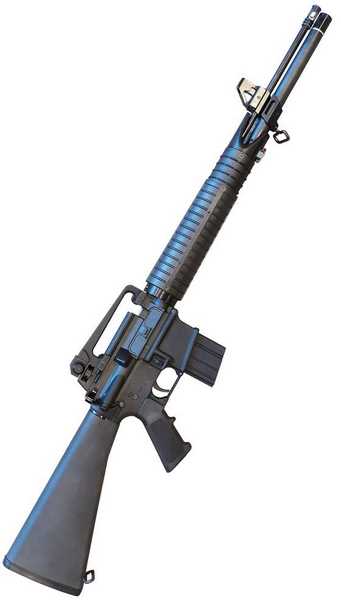
Crosman’s new MAR177 upper is big news! This view shows the front sight properly oriented.
Today is the first accuracy test day for the Crosman MAR177 upper, so let’s see how this baby shoots. Blog reader Darth Cossack pointed out that I had mounted the front sight backwards in the last report, so I fixed that for today’s photo. It wouldn’t have mattered from a shooting standpoint, but we do want the gun to look right.
On this AR-15, both the front sight and the rear sight adjust for elevation, while the rear sight also adjusts for windage. The front sight requires a sight adjustment tool that I don’t have and didn’t see packed with the upper. You can also use the point of a 5.56mm military round, which I have an abundance of, but doing it that way is very laborious. I’m hoping the rear sight adjustments will take care of everything that’s needed.
And one more time for those who didn’t read it — the MAR177 is purpose-built for the new sport of National Match Air Rifle (NMAR). NMAR can be shot with traditional 10-meter rifles (using the CMP classifications of Precision and Sporter) and the course is three positions — standing, kneeling and prone. You can continue to use your shooting glove, sling and shooting jacket for this sport, as well. Shooting trousers are not permitted.
The benefit of the AR-15 type rifle that the MAR177 is a part of is that it helps shooters transition over to National Match highpower shooting, because the lower that includes the trigger can be the same for both rifles. And from a competitive standpoint, the MAR177 is very affordable. The only other AR-type air rifle that’s suitable for this sport is made by Anschütz and sells for $1,850.
It cost me $450 to build my lower receiver, and half of that was the National Match trigger. If I wanted to build a lower on a budget, I could do it for under $200 by careful shopping. And I just saw a complete lower advertised in a local sale for $250. But the trigger would then be single-stage and heavier, though there are ways to gunsmith the pull weight down to the legal range of 4.5-5.0 lbs. And when I say the legal range, I refer to high-power competition, only. An air rifle has no trigger-pull limit, because Precision-class target rifles, which are the Olympic target air rifles, are permitted to compete in NMAR.
Why did Crosman make the MAR177 upper for a firearm lower?
This question is being asked by many airgunners. Why would Crosman knowingly make their upper to fit a lower that then classifies the whole rifle as a firearm under federal law? The answer lies in the tens of millions of AR rifles now in the hands of shooters and the extreme popularity of the model. Crosman is building for a market that is more than a hundred times larger than the current active airgun market in the U.S. Even if only a few percent of those owners decide to buy a MAR177, they represent more than all the active airgunners in the United States at this time.
But Crosman isn’t blind to the potential for sales of an MAR that’s not classified as a firearm. I have no doubt they’re working hard on a lower that will accept a modified MAR upper that will not be classified as a firearm. But these things take time. I would expect such a project to be on the fast track right now, but how long it might take before we see it is unclear.
The difficulties are enormous!
You probably think the MAR was easy to develop. After all — every AR is the same (they’re all held to certain specs), so don’t they just have to develop a gun for one lower that will automatically work on all the rest? Actually, no. When your upper has to interface with all the lowers on the market and all possible combinations of triggers in those lowers, there are bound to be some problems. Crosman did their due diligence in designing a universal upper, but there are bound to be some combinations of lower receivers and triggers that experience temporary problems. That would be true for any company designing any new AR-15 upper from scratch.
As I mentioned in Part 2, my Rock River lower and National Match trigger worked fine from the first moment I assembled the rifle, so every new owner can expect success, but there are bound to be some hiccups. There are synthetic lower receivers on the market that are being sold on a price basis that are known to have interchangeability issues with firearm uppers, and this is going to carry over to the MAR177 as well.
I’m not going to list those brands here, but if you do a search for AR-15 lower receiver problems, you’ll come up with a good list of what to avoid. The problems are both the lower receivers, themselves, and the separate parts kits to complete them. People are buying these receivers and parts based on price, alone, and they’re running into problems when one brand of lower won’t accept another company’s parts kit and then work with those three other uppers.
Somebody asked me why I chose a Rock River lower receiver and a Rock River parts kit, and I’m telling you why. There are other brands that are just as good, and a few that are even perhaps better, such as the Giessele National Match trigger that one of our readers mentioned, but you have to be aware of the fact that not all AR-15 uppers fit all AR-15 lowers.
What I’m testing
One final comment I want to make. Building a gun like this is full of decisions. You are free to choose whatever appeals to you; but once you choose, your path is determined by the decisions you make. As I said before, there’s no trigger-pull weight restriction in the NMAR class for air rifle shooting, but if I were to want to use the same lower in a match with a firearm, I would be restricted to a weight range for the trigger release and also the style of pistol grip. While I’ll probably never compete in a high-power military-style match, I wanted to shoot a gun that would qualify. It was a choice I made, and one that you do not have to follow. But that choice led me to a certain level of performance in the rifle I am now about to test.
I’m also shooting the military-style post front sight. An aperture front would allow more aiming precision; but if you want to use the MAR as a training tool for your high-power competition rifle, you’ll stick with the sights that come on the upper.
The test
I shot 5 shots per group off a rest at 10 meters with each pellet I tested. Since there’s going to be more testing with this gun, I didn’t try to test all the pellets I have, but I did try eight different ones.
Sighting in was done with the Crosman Premier Super Match target pellets that Crosman packed with my test gun. And they were astonishingly good! The group fired for record measured 0.144 inches between centers. That’s in the range for CMP (Civilian Marksmanship Program) and NRA Sporter class 10-meter rifles that have much lighter triggers and aperture front sights. I was impressed.
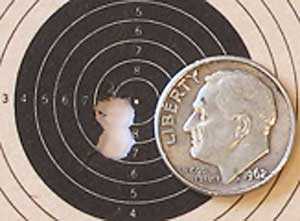
Crosman Premier Super Match pellets are great in the MAR177. Five shots went into a 0.144-inch group between centers at 10 meters.
Loading is not perfect
I used the single-shot tray for all this testing. This is the same tray that the Benjamin Marauder uses, and there’s a small gap just before the breech of the barrel. If you try to load the pellet tentatively, the head drops into the gap and binds. If you slam the bolt home too fast, the pellet jumps up in front and also jams. It takes a while to get the right closing speed so the pellet feeds smoothly. Not all pellets jam this way, but a couple are particularly bad. You’ll have to try it for yourself if you use the tray. I was able to get the feed right for every pellet I shot, so it’s not a problem — you just have to spend some time to learn the peculiarities of the gun with the ammo you choose.
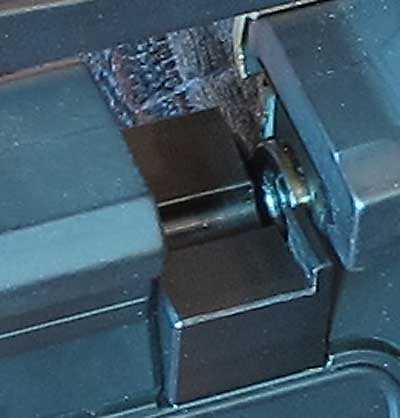
You can see the gap at the front of the single-shot loading tray. You have to learn how fast to load pellets to get wadcutters past that gap.
Number two
The second-best pellet in the test was the Gamo Match. While the group they made looks large, it’s so round that it doesn’t take up that much room. In reality, this probably means they’re not really second best, but I may have made a small aiming error with one of the other pellets. However, it’s surprising that such an inexpensive pellet is also this capable.
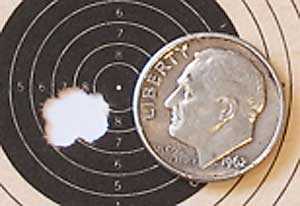
Five Gamo Match pellets made this 0.136-inch group. Second best of the test, though it appears open.
Best group
RWS R10 7.7-grain pellets that are no longer available gave the best results, with a group size of just 0.106 inches between centers. I shot them early in the test and was probably more rested than I was later, so my eyes were working at their best.
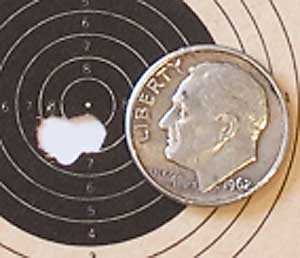
RWS R10 7.7-grain pellets made this five-shot group measuring 0.106 inches. It was the best of this test.
The other pellets
Besides these three, I tried five other target pellets. They were all very equal to the Crosman Super Match, and the largest group fired during the test was 0.162 inches with RWS Hobbys.
JSB S100 Match
Conclusions
One test like this is not enough to determine the most accurate pellet. If I were to do the same test again, the results would no doubt change. Lots more testing is needed to find that one best pellet for this competition air rifle. However, one test was sufficient to prove that the MAR177 has everything going for it. It’s accurate, easy to use and conserves air like a free diver. It mates to an AR lower perfectly to become the best possible training system for AR shooters.
I have more plans for this rifle. Next, I plan to mount a scope and test the rifle with accurate domed pellets at 25 yards. I believe the MAR177 has more to show us.

I’m going to call this reasonably priced. This because it’s fairly easy to have going to a single match cost $600 these days. And there are a LOT of high-power shooters in the US. So, there’s a sizable market for this goodie.
BB,
some great target shooting here, even with a bench rest! I assume because this rifle is a PCP that it’s not hold sensitive at all? That is, you were resting the rifle directly on the bench rest that you normally use without your hand supporting the forearm of the rifle?
Fred DPRoNJ
Fred,
Yes. The gun was rested as you described.
B.B.
BB, in the future you may want to look at the DPMS Panther Arms Uppers/Lowers/Rifles. The quality is very good.
Mike
Mike,
Yes, DPMS is good, and so is Armalite, Olympic and several others.
B.B.
The MAR 177 is on the cover of “Shooting Sports USA” magazine this month. There is a feature article with test target and pellet info as well as the development of the rifle. There is also an article about using a chronograph with air guns.
To clarify the rules of sporter class competition this is from the “National Standard Three-Position Air Rifle Rules” used by most sanction bodies including CMP.
4.2.3 Trigger Weight
The minimum trigger pull for a sporter air rifle is1.5 pounds.(680.4 grams). The cocked trigger must be capable of lifting a weight of 1.5 pounds. Trigger pull weights must be checked with…
There is no minimum trigger pull weight in the precision class listed in the rule book but they are typically adjusted between 50 and a 100 grams.
cavaman,
Now, isn’t that odd? because the rules also allow Precision-class rifle. And yet they cannot meet the trigger specificatons. I wonder how they work that?
B.B.
BB,
The precision class results are separated from the sporter class and awards are given to each class in other words they do not compete head to head even though they shoot shoulder to shoulder on the line. The only exception I know of is that a sporter shooter can be part of a precision team score but not the other way around.
cavaman,
Wow! Now that is weird!
Thanks for explaining that. For my money they are trying to accommodate too many people in this sport. They need to par it down to a real National Match competition with the same rules for everyone. This sounds like a sport designed by a committee.
B.B.
BB,
I don’t have any field target experience but don’t they do the same thing by having classes like open, springer, under 12 fpe, and so on? And don’t all the classes shoot the same course of fire at the same time?
I,m glad that the council has the sporter class because it lets people to get into competitive shooting without having to spend an obscene amount of money to be competitive. One of the rules is that a sporter rifle has to be available to clubs for under $600 (think of the Air Force Edge, they sell it with out sights just to meet that rule). For less than $1000 a person can get all the stuff they need to be competitive in the sporter class. On the other hand IMO it is crazy to start out in the precision class especially a young kid (8 to 12 years old) just an entry level jacket, pants, and pair of shoes will cost you $500 that they will grow out of in a year or less, not to mention the kid bouncing the muzzle of a $1500 rifle of the concrete all the time.
On another thought I think when they developed the MAR 177 part of the targeted consumer group where the younger shooters because of the “cool factor” of “black” rifles. Because for awhile the CMP was holding MAR only matches but now they have them lumped into the sporter class.
cavaman,
Yes, exactly. Field target (and every other sport I know) has CLASSES! This one doesn’t seem to have them. Just certain restrictions and oh, by the way, there is a Precision class, as well.
Maybe I just don’t understand how this works, but it appears they CMP has attempted to accommodate everyone in just two large, amorphous classes.
We already have ten-meter rifle. This is supposed to be National Match Air Rifle. I would like to see it represented that way, and not just a hodgepodge of rules that allow everyone to compete together.
Of they want to let in sporter-class rifles, make them compete in a Junior division, but not in something called National Match. Maybe that is exactly how they do it. As I say, I’m not that familiar with the sport.
B.B.
BB,
“We already have ten-meter rifle. This is supposed to be National Match Air Rifle. I would like to see it represented that way, and not just a hodgepodge of rules that allow everyone to compete together.”
I’m sorry but the 10 meter competition that has been around for decades in fact has been sanctioned by the ISSF (International Shooting Sport Federation” for inter national competition and sanctioned by the NRA and CMP for US competition. The NMAR (National Match Air Rifle) is a new discipline that was launched in 2010 and so far is of to a slow start.
Cavaman, congratulations on the purpose of the Anschutz rifle for your daughter. That model you mentioned is an upgrade over mine, and I can only imagine the effect on your daughter. Even at my mature vantage point, my rifle really rocks my world, so your daughter must be very proud.
Matt61
Matt61
Thanks and yes she is very pleased to have the rifle. It really isn’t an upgrade from your rig it has the same action and most likely the same trigger group. The big difference is the stock (and more expensive) and the reason we got it is it is very close to the stock on her air rifle so switching back and forth is easier. Now of to the range for practice!
I would love to see a higher-powered version of this, even if it offered very limited shots per fill, because what a great way to turn a varmint rifle into a small-game rifle, or hunt on very limited properties. I don’t have an AR in my collection yet, but a Colt is on my wish list (and a Noveske on a much wishier wish list!).
DerekB,
I would say just wait a while. Crosman cannot possibly have overlooked the possibility of turning this into a Marauder-type air rifle.
B.B.
You can save some money by getting the Noveske Upper and putting together your own lower.
MIke
When I buy an AR it will likely be my only centerfire rifle, so as an ‘everything’ rifle (including home defense) I would not be comfortable with something I assembled myself. Rather have a rock solid platform for training and any unlikely social needs.
For anyone looking for a general purpose centerfire AR15 rifle, a Colt model 6920 is hard to beat. If you shop around you should be able to find one in the $1100+/- range.
The 6920, or 6720 are at the top of my list for an AR when I’m in a position to buy one.
OT.
Where your danged ear protectors!!!
Okay…so we went out shooting yesterday. Had some new ammo for the boys XT-22 and my Savage. I remembered to pack their ear protectors, but for some reason mine were left out of the range bag.
Well heck, I’m tough…and they’re only rimfires, right.
Well after 30 rounds of .22WMR I have a dull ringing in my ears that is only just beginning to subside, 24 hours later.
Stupid is as stupid does.
CSD,
What you do is buy a box of disposable foam ear protectors and stick it in your range bag. Then you’ll always have ear protection.
B.B.
Yeow, don’t subject your ears to that kind of punishment. The WMR is a powerful cartridge, and besides I’m guessing you weren’t the only one on the range. Next time you may want to set the good and painful example for the boys by going back home for your ear protection.
I double up on the largest muffs I can find as well as protection inside that. I’ve tried cotton thinking that the material will disperse sound like mini-silencers in my ears. But I’ve also experimented with wadding up gun patches inside my ears, and those seem to be an improvement.
How did the sniper session go? Do you identify the rifle models?
Matt61
That is an excellent idea that I didn’t think of Matt. I always pack a cleaning kit complete with lots of patches…a wad of them would definitely have been better than nothing.
Driving home was not an option…the range is 45 minutes one way, which would have been a total of 3 hours driving time.
I’m definitely pleased that I chose the WMR…it has lots of ‘bang’, without the expense of centerfires, plus it is definitely proving to be more accurate than I was led to believe. Actually managed a couple of 3/4″ groups at 100yds…a range that was uptil now just impossible with our sub 500fps airguns.
Yet the great thing about air rifles is that last night shooting in my basement at 10m with my 853c was just as rewarding as the Savage at 100yds.
Anyhoo…the sniper report will have to wait a couple of weeks. Though it melted very quickly (quick enough that we were able to go to the range yesterday), the day we were to go with the police tactical team…well after a week of nice spring weather we woke up Thursday to 25cm (about 10″) of heavy wet snow.
Although in reality I was game to head out (I used to rally a Lotus Cortina in the 70’s) my police friend said he’d rather we not chance it. He said that if we did get into an accident that it could negatively affect their ability to have a member of the public tag along in the future.
So the sniper ‘event’ will have to wait…they practice the first Thursday of the month. But, he said to make up for it (like he has to) that in the next week or so if I can arrange a morning off from the boys school he will give us a tour of the Tactical Front Line, including a half hour on the pistol range.
My boys say they always have the best ‘show and tells’ at school.
Ear protection is really needed. Forty years of shooting has caused hearing loss in my left ear. It’s not bad but it’s there. These days, I use double protection. Plugs and muffs. I do use the plugs alone for hunting. It’s a must if you want to avoid problems in the future. Also, don’t forget protection in other high noise situation. Things like lawn mowers, chain saws, power tools, etc.
Mike
Now this is a good point that B.B. makes about the mix and match capabilities of the AR. If you really can mix and match various parts as advertised, that can’t help but be a positive attribute in the same way that the invention of interchangeable parts was for firearms. But if the various parts don’t quite match, then you not only have not really gained anything but may be worse off than average by operating in this zoo of parts where you’re never sure what works and what doesn’t. Think Mad Max where the title character walks around fitting shells into the breech of his shotgun to see if they work. And on the subject of interchangeability, there seems to be a particular problem with the AR magazine. The ability to slide the magazine straight in as opposed to rocking it in as you do for the M14 and AK47 is supposed to be a plus. But there seem to be big problems with the basic design of the magazine. If one of the triumphs of the 98 Mauser was its magazine which had something to do with the angle at which cartridges are fed into the chamber, then the AR magazine is a liability. When Delta Force undertook to redesign the M4 into the HK416, one area of special attention was the magazine. But at least for the MAR177 that doesn’t seem to be an issue as the magazine is fake. 🙂
Can’t argue with that accuracy. B.B. seems to be holding steady. Heartbeat and respiration normal…. I don’t recall the velocities for this rifle. But I thought that 10 meter guns were required to have a low velocity (the AAS200 is too high in many cases), so isn’t a 25 yard test a bit much?
Matt61
off topic. My Crosman 392 will pump up, but the air is leaking out the barrel and is all gone within a few minutes. Any quick home fix, or send it in for repairs?
thanks
Gene,
try dripping some Pellgun oil onto the pump head in the hope that it will get into the pressurized valve and help the O rings seal. Even dripping some oil down the compression chamber and then pumping. You are trying, again, to get oil into the storage chamber and thence to the O ring at the release valve end.
Fred DPRoNJ
Gene,
Oil the pump head liberally and then shoot the gun about 20 times in rapid succession. That’s the way to blow oil through the valve.
If it still leaks after that, the gun needs a rebuild.
B.B.
Thanks guys, I will oil it up good, shoot it 20 times and see what happens.
BB, you need a cyber tip-jar. lol
Gene: Mine did this just recently. If you pull the valve cartridge out of the rear of the gun and replace the O-ring around the outside of the cartridge , I’d be willing to bet that it will hold air when you pump it up. The O-ring can be bought at your local hardware for a buck . The size of the O-ring is 13/16×5/5x 3/32 (#12 ), lube it with a little silicone grease.
Typo: That’s a 13/16″x 5/8″ x 3/32″ O-ring.
This is *way* off topic, but may be interesting to some.
For years my son & I have wanted to visit Trinity Site in New Mexico, the place where the first atomic device was tested in 1945. We’ve put it off and put it off, but with my recent health scare I told him that this was the year and the month, and we protected this past weekend on our calendars. After all, I realize that I do not know when my ability to travel will be compromised, or his for that matter.
The site is about 2 hour & 15 minutes south of the Albuquerque airport and pretty easy driving. And it is open to the public on only two days a year: the first Saturdays in April and October, and then only from 8:00 AM to 2:00 PM. Despite the 67 years since the shot, close to 5,000 people show up for every open day. It’s rather more a fiesta than a solemn look at the dawn of the atomic era.
It’s extremely impressive. The crater has been filled in, mostly by natural processes, and the green glassy floor was dug up in the 50s, supposedly for safety reasons. However, a lot of “trinitite” glass is still there as pebbles and small rocks. However, the place is a National Monument and taking so much as a pebble is prohibited (and the place is crawling with volunteer docents and security).
Maybe the most impressive spot is the restored McDonald Ranch house where the bomb was assembled. They’ve put it back as it was on 16 July 1944 and installed a lot of photos and artifacts, most of which I’ve never seen before.
Certainly, it’s worth a detour if you’re in the area. If you’re a science/military history buff, you might (as we did) decide it’s worth a special trip!
pete
Pete,
what a great idea. My son is in Ardmore, OK, which is 90 miles from anywhere, but I think this is a great weekend trip – assuming he can get the time off. It is a long trip for him as it’s about 500 miles away but I would like to go!
Fred DPRoNJ
While wad cutters are easier to score, my experience has been that domes are more accurate. I shot some JSBs in my SAM M10 clamped in a vice years ago and was surprised at the (relative) improvement.
Best,
Joe
G’day BB
Great groups! Now I know you are measuring centre to centre but it seems strange that you can get a group less than .177″ which is the calibre. How big would a group be if they all went through a .177 hole? Would that be a 0.0″ group as there is only one centre?
How do you calculate/find the exact centres when you are measuring to 3 decimal places?
Cheers Bob
Bob,
Yes, if the pellets all went through the same hole the group would be 0.0″. It’s a quirk of measuring between centers and not the outsides.
I will do a blog on how to measure and you’ll see how easy it is.
B.B.
The simplest (though perhaps not the most accurate) is to measure the longest outside length, and subtract one caliber (half of each outer hole).
Most accurate if the line between those two pellet holes passes through the center of the group. May be a bit off if the line is to the side…
Sounds like an excuse to dig up my computer books from storage: I’ve got a copy for /R/ installed on this computer and should (with the text books) be able to rig up Monte Carlo simulations, then compute statistics based on actual centers vs outer-rim measurements… Probably too many statistics to prove anything <G> {Computing mean/standard deviation would only serve as a validation of data generator, since the most reasonable is to use a Gaussian random number with mean of 0 [bull] and deviation for spread; however, one could compute “actual” center for the group [the mean of the sample], then compute group center to each shot center distances, and compare 2x the maximum against the maximum of shot to shot c-t-c — I expect 2X group center to outlier will be larger than the maximum shot to shot distance.}
Joe, are you thinking of an MAR177? I know you do high-power matches, but can’t remember whether you do the service rifle stuff. If you get one, I wanna see it!
-Jan